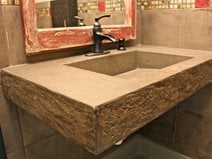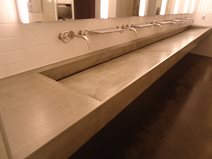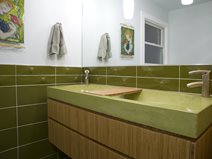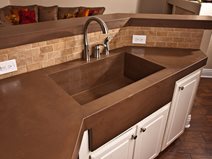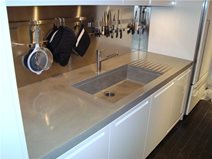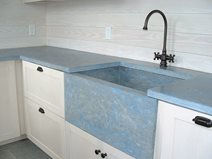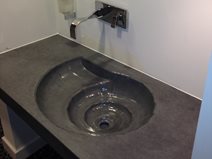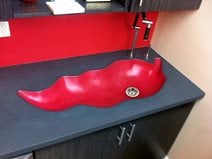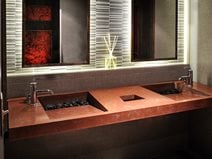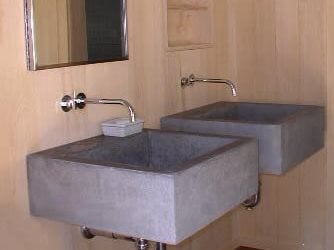- Sinks and Vessels Home
- Concrete Sink Pictures
- Integral Sinks
- Vessel Sinks
- Farmhouse & Trough Sinks: Plus other popular styles
- Design Ideas
- Bathroom Countertops: Designs and ideas for using concrete in the bathroom
- Bathroom Remodeling: Ideas for using concrete in bathroom remodels
- Concrete Sink and Tub Projects: Behind-the-scenes info and photos
- Six Design Ideas for Concrete Tubs
- Facts About Concrete Sinks
- How to Seal a Concrete Sink
- Using Prefab Sink Molds: How concrete sinks are made
A Guide to Concrete Sinks
Facts about concrete sinks and a look at the design options for bathrooms and kitchensMany homeowners and designers are finding that concrete sinks are a perfect fit for achieving distinctive-looking basins. Because concrete can be poured to shape any form, concrete fits the bill for any type of sink imaginable.
 Concrete Sink Pictures
Browse a gallery of custom sinks to get ideas for your home or business.
Concrete Sink Pictures
Browse a gallery of custom sinks to get ideas for your home or business.
 Bathroom Countertops
See how concrete can be used for bathroom counters.
Bathroom Countertops
See how concrete can be used for bathroom counters.
 Concrete Bathtubs
Discover six design ideas for creating distinctive concrete tubs.
Concrete Bathtubs
Discover six design ideas for creating distinctive concrete tubs.
 Concrete Kitchen Countertops
How to use concrete for custom counters and kitchen islands.
Concrete Kitchen Countertops
How to use concrete for custom counters and kitchen islands.
 Concrete Sink Molds
Prefab sink molds are a great way to create custom sinks for bathrooms and kitchens.
Concrete Sink Molds
Prefab sink molds are a great way to create custom sinks for bathrooms and kitchens.
 Countertop Design Videos
Watch 16 videos with expert design ideas for using concrete countertops in residential and commercial settings.
Countertop Design Videos
Watch 16 videos with expert design ideas for using concrete countertops in residential and commercial settings.
Whether it's square, rectangular, oval, round, or integral, concrete can be shaped to blend into any decor and style. Concrete sinks, vanities and pedestals, marked by the elegance of deep colors and strong, clean lines, add drama, style and grace to any bathroom or kitchen.
Find a Contractor: Concrete Sinks Near Me
CONCRETE BATHROOM SINK IDEAS
Concrete has become a popular choice for bathroom sinks both in homes, restaurants, theaters and more. You can opt for a concrete sink vanity or go with a vessel sink that sits atop the counter.
A floating concrete sink gives this bathroom a unique look. A special casting technique was used to make it appear like a thick piece of stone with a rough edge. A simple square basin makes it both functional and attractive.
This wall-to-wall ramp-style concrete sink in a locker room bathroom conveys an industrial, no-frills look. Additional features include a slot drain along the back and plenty of wall-mounted faucets.
Homeowners often opt for concrete sinks in their bathrooms because of the unmatched customization options. Liquid pigments were used to bring playful color to this double vanity.
Get more concrete sink design ideas from this collection of unique projects.
CONCRETE KITCHEN SINK DESIGN
Concrete sinks are also an option for your kitchen. Use concrete to create a custom farmhouse sink or a simple integral design that flows seamlessly with your concrete countertops.
A rich brown color makes this kitchen sink warm and inviting. It was cast integrally with the surrounding front apron, concrete countertops, and bar.
This modern, square sink is deep enough for washing large pots and has an integrated drainboard on one side. The color coordinates nicely with the stainless steel backsplash.
This farmhouse kitchen puts a twist on traditional design with its blue counters and custom concrete sink. A large front apron gives the sink a massive feel.
See more farmhouse and trough style sinks.
HOW TO MAKE A CONCRETE SINK
Concrete Sinks
Time: 01:37
Concrete sinks are made using high performance concrete and special molds. Reusable sink molds make the process easier and come in many styles. But if you want something different, ask your contractor if they can build a custom mold to your liking.
Here’s an overview of the sink making process:
- Prepare the mold
- Cast the concrete
- Let the sink cure
- Remove the mold
- Seal and install
In most cases, concrete sinks are made in a shop and then transported and installed. However, they can also be cast-in-place if necessary.
 Slot Drain Ramp Sink Mold
72" with internal reinforcement
Slot Drain Ramp Sink Mold
72" with internal reinforcement
 Rectangle Sink Mold
Internally reinforced. Ships in 2 to 3 business days.
Rectangle Sink Mold
Internally reinforced. Ships in 2 to 3 business days.
 Mold Making Kit
Create custom rubber molds for concrete casting
Mold Making Kit
Create custom rubber molds for concrete casting
COLOR OPTIONS FOR CONCRETE SINKS
One of the benefits of choosing concrete for your sink is the range of colors available. Each concrete contractor offers his or her own unique standard and premium colors. And many will create custom colors to help you match or complement other materials.
Samples will always be different because each contractor has their own secret recipe and different types and amounts of cement and aggregates. In fact, cement will vary in different parts of the country. There are different brands of pigments, stains, and aggregate colors, so concrete sinks will always be one-of-a-kind.
The most popular method for coloring concrete sinks is integrally. Color pigments are added to the concrete mix before the sink is cast, creating consistent color throughout the entire piece. The hues available are nearly limitless, ranging from earth tones to more vibrant colors. Learn more about using integral colors to bring life to sinks: Paint-By-Number Concrete Color.
Concrete sinks can also be colored topically with stains. Stains produce a mottled look that many people like for its organic appeal. Typically available in earth tones, stains are great if you want a subdued sink.
Color inspiration for concrete sinks:
Black Ammonite Sink
A little black pigment was added to this custom fossil-inspired sink to slightly darken the grey cement.
Red Hot Chili Pepper Sink
This sink's countertop was colored in a custom gray made with integral iron oxide pigments. The red basin was also integrally colored.
Walnut & Red Oxide Combo
The concrete used to cast this double sink was integrally colored with a blend of walnut and red oxide pigments. To achieve a variegated look, the piece was intentionally cast with voids that were filled with a gray slurry mix.
Green Vanity Sink
For this concrete vanity with integral sink custom liquid pigments in Key Lime were used to accentuate a tile mosaic.
FREQUENTLY ASKED QUESTIONS
If you're considering a concrete sink, you may have additional questions. Here are some questions answered by various decorative concrete companies.
FROM BUDDY RHODES STUDIO:
Does the concrete ever crack?
Yes, hairline cracking may occur. These are not structural and are part of the character of concrete.
What if I want a color that is not in the sample package?
We can make custom colors attempting to match almost any color, there is a $75.00 charge that is applied to your order.
Does the color ever vary?
Yes, every order is custom which lends to the products uniqueness.
FROM COUNTERCAST DESIGNS:
What about seams?
Seams are approximately 0.25" and filled with matching epoxy grout. Although visible, they do not detract from the aesthetic quality at all.
Will they crack?
No. With our proprietary mix, steel and glass-fiber reinforcement coupled with special curing techniques and additives, we guarantee our products against structural cracking under normal conditions. Hairline cracks (literally a hair's width and invisible from 3 feet away) are inherent in concrete and may occur. They are superficial and often make the concrete look even more like stone.
Do you build them in my house?
Absolutely not. All our work is PRECAST in our workshop with very few exceptions. Working off-site allows us to create our custom sinks, special integral features, edges and finishes; control important elements such as temperature, humidity and water which affect curing and strength; and to utilize any special equipment, machinery and materials without worrying about a customer's cabinets or interior. Our techniques, without exception, produce the highest quality and strongest concrete available today.
FROM GROTTO DESIGNS:
Are concrete sinks durable?
A concrete sink can potentially last forever. Under normal use your concrete countertop, sink or vanity will outlast the house that it is in. The only thing that can deteriorate concrete is prolonged exposure to salt water or freeze/thaw cycles.
Is it heavy?
Our standard mix using lightweight aggregates weighs approximately 12lb. - 13lb./sq. ft. for 1.5" thickness. This is well within load capacities for standard North American residential construction and modular kitchen cabinets. In general, no extra support or stiffening is required. Using fiber and polymer additives concrete slabs may be cast much lighter with greater span capabilities.
How thick is it?
1.5" thick is standard and as thin as 0.75" for slabs. Drop edges of up to 12" may be incorporated for a heavier look. Tiles and panels may be as thin as 0.5
Does it look like a sidewalk?
Absolutely not! In general, our surfaces are as smooth as glass. If anything, it looks like stone with the added characteristic that it may be colored to create depth and richness. We like to say it looks like concrete!
Will it crack?
If it hasn't cracked by the time it leaves our shop then it's not going to. Concrete continues to harden for up to 50 years. Due to casting and reinforcement techniques used and proper curing, structural cracks are extremely rare. Superficial hairline surface cracks may, in time, occur but do not affect the strength or functionality of the concrete in any way and may even add to the organic appeal of the material.
Are there seams?
Yes, there are seams. They are less than 1/8" wide and filled with matching grout. Seams do not detract from the overall appearance of the concrete, on the contrary, they add character and dimension.
How long does it take?
Concrete must cure at least 14 days before it is safe to transport. We prefer to double that. So, expect 4 - 6 weeks from the time we receive templates.
Is it cheaper than granite?
It can be, and most of our standard items are. However, making concrete is labor intensive. Each piece is individually made and requires many steps to a final product. Custom pieces and complex shapes may cost more than granite.



